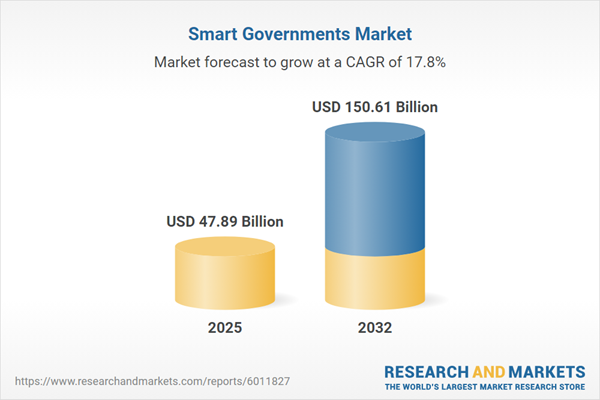Speak directly to the analyst to clarify any post sales queries you may have.
Senior decision-makers in public sector organizations are accelerating the adoption of smart government technologies to modernize service delivery and strengthen operational resilience. This market research report offers targeted analysis and actionable recommendations to guide digital transformation efforts, supporting effective leadership in today’s evolving government landscape.
Market Snapshot: Smart Governments Market Growth Drivers
The smart governments market is experiencing rapid expansion, with global investments in digital infrastructure and real-time data solutions shaping its evolution. Strategic commitment to citizen-first approaches is leading agencies to implement agile, secure, and adaptable platforms that enable responsive service delivery. Modular technology systems and cloud-based frameworks provide scalability, allowing public sector organizations to keep pace with changing regulatory requirements and continuous modernization. The increasing demand for transparency, efficiency, and security is driving sustained momentum across diverse government operations, with digital transformation positioned as a key enabler for resilient public services.
Scope & Segmentation
- Component: Services such as consulting, advisory, training, and system integration support the deployment of smart solutions, while hardware, IoT devices, analytics software, platforms, and security applications underpin scalable operations.
- Application: The market addresses asset management, citizen engagement, resource optimization, public sector security, and comprehensive data analytics, enhancing efficiency, accountability, and transparent government processes.
- Deployment Mode: Agencies choose from cloud models including hybrid, community, multi-cloud, private, and public, alongside traditional on-premises infrastructure for specialized IT control or policy needs. Leading providers like Amazon Web Services, Google Cloud Platform, and Microsoft Azure offer solutions tailored to public sector requirements.
- Technology: Innovations in artificial intelligence, machine learning, big data analytics, blockchain, cloud computing, and the Internet of Things enable automation and informed decision-making, supporting continuous digital transformation across agencies.
- Department: Sectors such as education, healthcare, public safety, transportation, and utilities leverage integrated technology to streamline data flows and optimize resource allocation for both daily management and strategic planning.
- Regions: The market’s reach spans the Americas (including the US, Canada, Mexico, Brazil, Argentina, Chile, Colombia, and Peru), Europe, the Middle East and Africa (with prominent adoption in the UK, Germany, France, Saudi Arabia, and South Africa), and Asia-Pacific (including China, India, Japan, Australia, and South Korea). Each region adopts smart government strategies according to digital readiness and regulatory context.
- Leading Companies: Providers such as IBM Corporation, Microsoft Corporation, Accenture plc, Cisco Systems, Oracle Corporation, SAP SE, Huawei Technologies, NEC Corporation, Atos SE, and Siemens AG deliver secure and scalable frameworks essential for government transformation initiatives.
Key Takeaways for Senior Decision-Makers
- Adopting a citizen-centric approach to service design increases public satisfaction and strengthens organizational transparency.
- Integrating data across departments and automating workflows heightens responsiveness, addresses inefficiencies, and improves the ability to handle emerging challenges.
- Building workforce capacity through ongoing training and targeted talent recruitment in data science and cybersecurity maintains knowledge and enables successful implementation of advanced technology.
- Implementing agile governance and privacy protocols equips public sector agencies to adapt to evolving regulatory environments and safeguard sensitive information.
- Forging alliances with regional bodies and forming partnerships with technology vendors helps manage procurement costs and adapt to fluctuating trade conditions.
Tariff Impact on Procurement and Budget Strategy
Recent tariff adjustments in the United States are prompting government agencies to reassess supply chain resilience and pursue updated agreements with technology vendors. To address these challenges, organizations emphasize regional partnerships and local production, balancing cost pressures through performance-based procurement, phased deployments, and targeted pilot projects. These approaches enable public sector leaders to maintain operational agility while navigating volatile global trade environments.
Methodology & Data Sources
This report is grounded in extensive secondary research, thorough policy and market analysis, and first-hand interviews with industry executives and technology leaders. Data is independently validated and enhanced with advanced analytics and visualization for informed insight.
Why This Report Matters
- Senior government leaders receive comprehensive insight on digital government transformation and critical market trends for effective innovation.
- Detailed segmentation aligns technology strategies and operational planning with unique organizational and regional objectives.
- Actionable recommendations help agencies navigate procurement complexities and regulatory requirements to implement secure, scalable solutions.
Conclusion
Senior decision-makers can use this report to lead digital transformation with data-driven strategy, cross-functional collaboration, and adaptable leadership frameworks, positioning government organizations for sustained modernization and improved resilience.
Additional Product Information:
- Purchase of this report includes 1 year online access with quarterly updates.
- This report can be updated on request. Please contact our Customer Experience team using the Ask a Question widget on our website.
Table of Contents
3. Executive Summary
4. Market Overview
7. Cumulative Impact of Artificial Intelligence 2025
Companies Mentioned
The companies profiled in this Smart Governments market report include:- IBM Corporation
- Microsoft Corporation
- Accenture plc
- Cisco Systems, Inc.
- Oracle Corporation
- SAP SE
- Huawei Technologies Co., Ltd.
- NEC Corporation
- Atos SE
- Siemens AG
Table Information
| Report Attribute | Details |
|---|---|
| No. of Pages | 182 |
| Published | October 2025 |
| Forecast Period | 2025 - 2032 |
| Estimated Market Value ( USD | $ 47.89 Billion |
| Forecasted Market Value ( USD | $ 150.61 Billion |
| Compound Annual Growth Rate | 17.7% |
| Regions Covered | Global |
| No. of Companies Mentioned | 11 |









